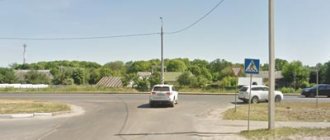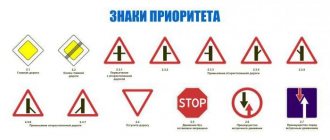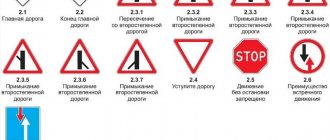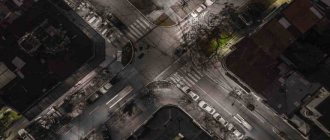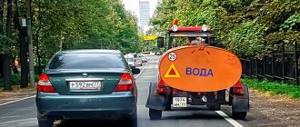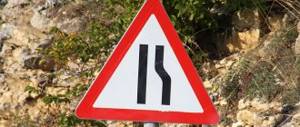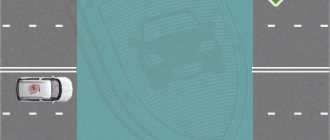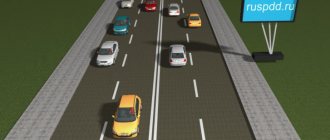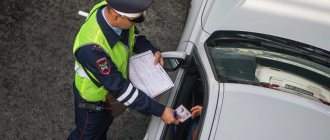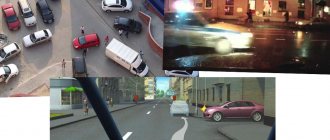When the main road changes direction, many drivers, especially beginners, have problems quickly understanding who should yield to whom. The rule for passing at such intersections sounds simple.
13.10. In the event that the main road changes direction at an intersection, drivers moving along the main road must follow the rules for driving through intersections of equivalent roads. Drivers driving on secondary roads should follow the same rules.
13.11. At an intersection of equivalent roads, the driver of a trackless vehicle must give way to vehicles approaching from the right. Tram drivers should follow the same rule among themselves. At such intersections, the tram has priority over trackless vehicles, regardless of the direction of its movement.
That is, if we decipher this rule, drivers on the main road let the obstacle on the right from the main road pass, and drivers on the secondary road let those on the main road and those driving on the right on the secondary road pass.
At the same time, all drivers should not forget about trams and pedestrians. On the main road, trams, which are also on the main road, regardless of the direction of their maneuver, and all pedestrians pass, and on the secondary road, ALL trams pass
Difficulty driving through intersections where the main road changes direction
How to remember who to skip
If you are moving along the main road, you must assess as you go who you should let through and who you shouldn’t. To make a decision quickly, remember simple mnemonic rules. These mnemonic rules will be especially useful for beginners who are drowning in the sea of information that befalls them on the road.
Attention! These rules allow you to remember the order of passage for trackless vehicles! As soon as you see tram lines, you must remember that a tram located on the same road as you always has an advantage over you. So let the trams pass, and then you can apply the passing rules for trackless vehicles.
1) When you approach an intersection and
you are on a main road and the main road turns left
mnemonic rule:
- Main left - ride like a queen
(Especially easy for women to remember; men can imagine themselves as a chess queen. Which, as you know, goes anywhere)
This means that you make any maneuvers and should not give way to any non-rail vehicle. You ALWAYS give way to pedestrians at uncontrolled intersections.
Even those drivers who are also on the main road will give way to you during any maneuver, because for them, with such a main turn, you turn out to be an obstacle on the right.
2) You drive up the main road and the main road turns right
- main to the right and interference to the right
This means that you give way during any maneuver only to those moving on the right
If you are approaching an intersection on a secondary road
Then you can remember the picture on the sign, just as you remember the waxing and waning moon
3) If you can complete the drawing so that you get the letter P, then it’s a mnemonic rule
- Home Growing - I'm unlucky
This means that you let everyone through and go through the intersection last.
4) If the main one looks like the letter C
- that mnemonic rule:
- Home Old lady - I have a bun
This means you let everyone through except those on the sidelines. For them, you are a hindrance on the right, and have an advantage.
In fact, it is especially important to remember the first two mnemonic rules, since those who are on the main road are driving at speed and must assess the situation faster than those who are driving on the secondary road and know that they need to let almost everyone pass.
But knowing all four mnemonic rules for driving through an intersection where the main road changes direction will help you crack all such tasks like nuts in the traffic police exam.
In general, as they say, it could be simpler. But no, a holy war broke out on one of the forums over the question of who gives way to whom when changing the direction of the main road. The situation is painfully simple and occurs quite often. The main road changes direction to the right. The blue car wants to drive straight and leaves the main road. Purple continues on the main road to the right. Who is inferior to whom?
The main road changes direction at an intersection - how to continue driving
Today, not only State Traffic Inspectorate employees are responsible for regulating traffic, but also the signs that are installed near the road with traffic lights. All drivers are accustomed to relying on traffic lights when passing through an intersection - with its help they can understand which traffic is going where.
However, there may also be unregulated intersections on the road. At first glance, driving through such an intersection does not seem difficult. However, this can only be said about those cases when the main and secondary roads intersect in direct directions. If the driver is faced with a situation where the main road turns to the side, questions arise - who gives way to whom and when.
Let's consider this case and at the same time analyze another situation - how to determine the priority of movement when asphalt and dirt roads intersect, and what to do in cases where the surface is very difficult to see. In practice, such cases are regulated by 2 traffic rules.
What is an uncontrolled intersection ? Before we start studying the rules, let's remember what an unregulated intersection is. Paragraph 13.3 of the Traffic Regulations states that an intersection at which there are no traffic lights and no traffic controller should be considered unregulated. There are cases when there is a traffic light, but it is broken and only the yellow signal works - the intersection of roads can be regarded as unregulated. The traffic order should be determined according to the rules of passage and priority signs, if they are installed in this area.
The main road goes into a bend . At an intersection where the main road does not continue straight, but to the side, you need to act according to a simple rule - the driver on the main road, and then on the secondary road, continues to move, guided by the rules for crossing equivalent roads. Paragraph 13.10 of the traffic rules states that a vehicle moving on the main road has priority and can pass the intersection first. In this case, you need to act as if priority is not indicated anywhere, and rely on the interference rule on the right side. After them, cars from the secondary road can start moving, which operate on the same principle.
How to identify a main road without signs . Now is the second time we have passed through such an intersection, which not many people remember. Not everyone knows how to find out which road has priority if there are no signs nearby. The traffic rules indicate that a paved road has priority over a dirt road. Therefore, a motorist driving on a secondary road is obliged to yield to other cars.
What to do when coverage cannot be determined . The rule for determining road surfaces does not seem complicated. However, in real life there are often cases when it is impossible to say exactly what kind of coating passes in this direction. This happens if there is snow or ice on the road. This case is provided for in the rules. Paragraph 13.13 of the Traffic Regulations states that if the driver cannot determine the type of surface, and there are no priority signs at the intersection, he must assume that his direction is considered secondary. In this case, you need to give way to vehicles moving on the right and left sides.
Bottom line . Crossroads are considered the most dangerous areas on the road, so they try to regulate them with the help of signs and traffic lights. There are no big problems when the main and secondary roads intersect in direct directions. However, drivers get confused when the main road turns to the side. In such cases, you need to be guided by only two rules described above.
see also
Comments 243
Here the broken marking line in the disputed area is interrupted for good reason - the purple one is inferior in terms of “interference on the right”.
Sorry, I didn't even look. My answer. If the markings or signs allow you to turn in more than one lane, then the blue one (if he intends to move straight) has nothing to do there, accordingly, creating an obstacle, he changes lanes, crossing the turning lanes and he went into the stump, let him wait until they let him go straight with a left turn signal. If Since neither the signs nor the markings allow turning from the second lane, then you can only turn from the right lane, respectively, the purple stupid donkey, and when changing lanes, you must let it pass, and only then turn from the right lane. But in any case, if you don’t bully, and are mutually respectful and, moreover, in solidarity, then such incidents can be overcome with a bang.
Traffic services are to blame!
Before such intersections, it is necessary to place signs “Direction of traffic along the lanes”
Drivers who don't know the rules are to blame. The situation is clear, and the author analyzes it and perhaps saves someone’s life and definitely saves the family budget from wasting money on car repairs.
Don’t like people’s brains! And watch your language, you couch potato. Here you are brave and skillful, on the road it’s the same, most of the accidents are because of people like you, too smart and self-confident! You don’t need to teach me, I’ll teach whoever you want, you can do this with your children, another generation of oakheads will grow up.
Oil... Did you understand what you wrote? Be bold in another place and with other people, since you can’t finish reading the text to the end.
Yes, I read it here and in ah...e. This is how people drive on the roads. It feels like somewhere the cops are losing at cards.
You are absolutely right;-)
It may be rude, but in this case two morons violate both, but it’s a shame that there are more and more of them on the roads
Maybe in Belarus both morons violate... we have only one in such a situation.
Well, you may have a simple respectful attitude and adherence to the basics of traffic rules, although like us (whoever has a cooler car and smaller brains and more connections is right), but isn’t it easier to look at the signs in advance before turning and not create moronic situations. Maybe I'm wrong, but sometimes you want to mix up the pedals when a scumbag jumps out in front of you and only in his own opinion is everything possible
What's so moronic about driving straight through an intersection in the right lane?
Nothing if there is no moron on the left
What's so moronic about driving straight through an intersection in the right lane?
You are approaching an intersection in
What's so moronic about driving straight through an intersection in the right lane?
You are approaching an intersection in the right lane; a car is driving or stopped without a turn signal. Your actions (1, you occupy the left lane to turn right on the main road, or 2, take the right lane and turn right)
Why not 3 - I’ll take the right lane and go straight? By God you are from the village; in the city you can rarely drive through intersections in the left lane. If there are no lane signs, I ALWAYS drive straight and to the right from the right lane. And I’m not going to deliberately occupy the left lane to drive straight through the intersection.
What is the dispute about? At the intersection in the picture there is only one moron in a purple car. Blue didn't break a single rule AT ALL.
So I’m talking about the same thing: if you’re on the right, take the right lane, wait, go left, and if you can’t go straight and can’t stand it, you can go straight from the left lane and the moron on the left won’t get out to look around, I’m talking about the fact that on roads that are especially resistant, more and more somewhere So
The rules clearly state that when turning right, take the far right lane... to be honest, excuse me, but because of such idiots, something always happens, wasn’t it really impossible for the purple one to move into the right lane in advance, and the blue one into the left? ?! For me, the blue one is creating an emergency situation, and the purple one seems to be driving along the main road, so he doesn’t understand what he’s doing... just imagine the flow, everyone is going to the right along the main road, and then some f... from the right lane wants to rush in a straight line , what is stopping him from rebuilding? Lack of knowledge of the rules or, on the contrary, knowledge of them, stupidity or greyhound? This way you can stir up setups, you will drive to his left, but then he suddenly wanted to go straight... In the end, you are to blame
The main road turns right
In this case, 2 signs must be installed simultaneously in front of the intersection:
The situation is regulated by clauses 13.10 and 13.11 of the traffic rules:
13.10. In the event that the main road changes direction at an intersection, drivers moving along the main road must follow the rules for driving through intersections of equivalent roads. Drivers driving on secondary roads should follow the same rules.
13.11. At the intersection of equivalent roads, with the exception of the case provided for in paragraph 13.11 1 of the Rules, the driver of a trackless vehicle is obliged to give way to vehicles approaching from the right. Tram drivers should follow the same rule among themselves.
Now let's move on to applying this rule in practice.
Right turn
In this case, you can safely perform a turn. You won’t have to give way to anyone, because... There cannot be any other vehicles to the right of the white car.
Go straight
When driving straight, you must give way to all cars driving on the right on the main road (orange car). In this case, it does not matter what maneuver the orange one plans to perform (turn, turn or move straight). When entering an intersection, he in any case has the right of way.
Pay attention to the situation when the orange car is making a U-turn. When entering the intersection, the orange car is on your right, i.e. has an advantage. However, during the turn, the car may end up on your left, in which case you will have the advantage.
Turn left or make a U-turn
Also, as in the previous case, it is necessary to let all vehicles approaching along the main road on the right (orange car) pass.
Popular cars
Exit the main road straight ahead.
Remember, Kadabra resident @ibeono stated in his post This statement is incorrect,
point 8.1,
I’m talking in this post only about the congress directly.
However, comrade @ibeono was unable to cite the traffic rules clause.
That is, according to him, if we are driving through an intersection along the main road, and the main road at the intersection turns somewhere, and we continue to go straight
and we move onto a secondary road, then we still have to show the turn signal just because... we are leaving the main road!!
Absurd?!!
I figured out the traffic rules and therefore the issue, and found why this is so. Welcome to cat. First, you can look at the place that comrade @ibeono had in mind:
https://maps.yandex.ru/-/CVuvFN4i
Here, as I understand it, the main road turns right, and we go straight.
I will redraw this diagram in the Kadabra road editor, but in the absence of such a sign in the Kadabra editor
, I’ll draw the Main Road in the other direction, for my story the direction of the main road is not important.
This is what the respected Kadabro resident means:
We're going straight, but since we're leaving the main road, we have to show the turn signal!
Let's figure it out.
So, let's look at the definitions
"Main road" - road
, marked with signs 2.1, 2.3.1 - 2.3.7 or 5.1, in relation to the one being crossed (adjacent), or a hard-surfaced road (asphalt and cement concrete, stone materials, etc.) in relation to a dirt road, or any road in relation to to exit from adjacent territories. The presence of a paved section on a minor road immediately before the intersection does not make it equal in importance to the one it intersects.
“Road” is a strip of land or a surface of an artificial structure equipped or adapted and used for the movement of vehicles. A road includes one or more carriageways
, as well as tram tracks, sidewalks, roadsides and median strips, if any.
“Crossroads” is a place where roads intersect, join or branch.
on the same level, limited by imaginary lines connecting, respectively, the opposite, most distant from the center of the intersection, beginnings of curvatures of the roadways. Exits from adjacent areas are not considered intersections.
“Traffic lane” - any of the longitudinal stripes of the roadway
, marked or not marked with markings and having a width sufficient for the movement of cars in one row.
“Changing lanes” is leaving an occupied lane or occupied row while maintaining the original direction of movement.
Now let's turn to paragraph 13.10
13.10. In the event that the main road changes direction at an intersection, drivers moving along the main road must follow the rules for driving through intersections of equivalent roads. Drivers driving on secondary roads should follow the same rules.
From paragraph 13.10 it follows that the main road at the intersection is ONE
.
Other clauses also speak of the main road in the singular. This point makes it clear that there is ONE
, which can change direction.
So, the considered intersection consists of two roads.
The red road is the main one, the blue one is the secondary one.
There is not a straight road here and there is a branch to it on the left
, and one road that changes direction (the main one), and a secondary one adjoins it in front. Remember, we only have ONE main road.
And now to the actual conclusion:
An intersection is a place where roads intersect. The main road is also a road. A road consists of a carriageway, and a carriageway consists of stripes. When changing one road for another, you correspondingly change a lane of one carriageway, to another lane of another carriageway. And this is a rebuild. And changing lanes must be accompanied by the turn signal on - clause 8.1
UPD
: I DO NOT agree with comrade @ibeono that when turning along the main road there is no need to show turn signals.
UPD 2
: I think this is nonsense, if anything, I just assumed why this is so.
UPD 3
: here
I am not going
to show the turn signal
And in the picture above - for safety, you can. In short, traffic rules are traffic rules, but life is life. I'm going to act by the spirit of the law, not the letter.
UPD 4
: Listen to the smart comrade @todeus, with whom I agree:
PS: There is no main road at an intersection! It's right at the crossroads. The diagram drawn above with the main one being red and the secondary one being blue is absurd. If we look at it this way, then the blue secondary lane does not end at the border of the intersection of roadways, it continues further along the intersection and further down! And it turns out that at the intersection we have both a blue and a red sector. The road is both blue and red, main and secondary, what nonsense. There is NO main road at a crossroads. G. The road is different for everyone. If you enter an intersection with a secondary road, then through the intersection you continue to drive along the secondary road! If you enter an intersection from the main road, then at the intersection you continue to drive along the main road!
The main road turns left
In this case, the following combination of signs must be installed in front of the intersection:
The situation is regulated by the same paragraph 13.11 of the traffic rules:
13.11. At the intersection of equivalent roads, with the exception of the case provided for in paragraph 13.11 1 of the Rules, the driver of a trackless vehicle is obliged to give way to vehicles approaching from the right. Tram drivers should follow the same rule among themselves.
Right turn
When turning right, the white car has the right of way, i.e. no need to let anyone through.
Please note that when approaching an intersection on the main road and then turning right, you always have the right of way.
Go straight
The white car has priority and is not required to let anyone through.
Left turn
There is also no need to let anyone pass when performing this maneuver.
U-turn
This is the only maneuver that may result in a priority vehicle being on the right side of your vehicle in this situation. When making a U-turn, you need to give way to cars driving on the main road, because... in the final phase of the turn they are to your right. We are talking about the green car in the picture.
I would like to note that when driving through an intersection on the main road, you are not required to give way to cars approaching on a secondary road. Traffic rules, paragraph 13.9:
13.9. At the intersection of unequal roads, the driver of a vehicle moving on a secondary road must give way to vehicles approaching on the main road, regardless of the direction of their further movement.
Accident at an intersection, main road
If an intersection is equipped with a traffic light, traffic is regulated by its signals. And there is no controversial situation regarding who should give in to whom. Obviously, during the collision, the driver who was driving at the green light was on the right.
Everything looks different when the intersection is unregulated. It can be the intersection of unequal paths, that is, the main (main) and secondary. The first is indicated by a symbol in the form of a yellow diamond with a white border. Cars moving along it have the right of way.
And vehicles turning there from a secondary road or passing through an intersection must wait. This is required of him by the “Give way” sign in the form of a white triangle with a red border, located with the base up. If the condition is not met, a collision occurs. This means a violation of clause 13.9 of the traffic rules:
At the intersection of unequal roads, the driver of a vehicle moving on a secondary road must give way to vehicles approaching on the main road, regardless of the direction of their further movement.
In most such situations, the one who was driving along the secondary route is found guilty. He will be punished for violation of Part 2 of Article 12.13 of the Administrative Code:
Failure to comply with the requirement of the Traffic Rules to give way to a vehicle enjoying priority right of passage through intersections shall entail the imposition of an administrative fine in the amount of one thousand rubles.
The insurer of the culprit will compensate for material and physical damage caused to another participant in the accident. This is determined by paragraph 1 of Article 12 of the Law on Compulsory Motor Liability Insurance:
An application for insurance compensation in connection with harm to the life or health of the victim is sent to the insurer that insured the civil liability of the person who caused the harm. An application for insurance compensation in connection with damage to the property of the victim is sent to the insurer that insured the civil liability of the person who caused the damage...
If direct compensation for losses is possible, the company that issued the policy to the victim pays.
Features of driving through an intersection on the main road
When approaching an unequal intersection, you should always remember that the driver of a car on a secondary road may not know the rules of the road and will try to pass the intersection first.
Naturally, in the event of a collision, the offender will be the culprit, but this will not make it any easier for the second driver. Registration of an accident and car repairs take quite a lot of time. Therefore, it is better to slow down and let a car pass on a secondary road than to be involved in an accident.
So, when approaching an intersection on the main road, first of all, make sure that they really give way to you.
How can you determine which road is the main one if the sign is not installed?
In every locality, the “Main Road” sign, a photo of which you can see in this article, is installed in front of intersections. But let's also clarify how you can determine the main road if this sign is not there?
In such cases, both the road surface and the location of adjacent roads will help you out. Only the one with a hard surface in relation to the unpaved ones, or the one that is adjacent to exits from nearby territories, will receive the main status.
By the way, keep in mind that even if there is a pavement on the secondary road in the area adjacent to the intersection, it still does not become equal in importance to the one that crosses it.
